The Bulldozer Review: AMD FX-8150 Tested
by Anand Lal Shimpi on October 12, 2011 1:27 AM ESTThe Test
To keep the review length manageable we're presenting a subset of our results here. For all benchmark results and even more comparisons be sure to use our performance comparison tool: Bench.
| Motherboard: |
ASUS P8Z68-V Pro (Intel Z68) ASUS Crosshair V Formula (AMD 990FX) |
| Hard Disk: |
Intel X25-M SSD (80GB) Crucial RealSSD C300 |
| Memory: | 2 x 4GB G.Skill Ripjaws X DDR3-1600 9-9-9-20 |
| Video Card: | ATI Radeon HD 5870 (Windows 7) |
| Video Drivers: | AMD Catalyst 11.10 Beta (Windows 7) |
| Desktop Resolution: | 1920 x 1200 |
| OS: | Windows 7 x64 |
Windows 7 Application Performance
3dsmax 9
Today's desktop processors are more than fast enough to do professional level 3D rendering at home. To look at performance under 3dsmax we ran the SPECapc 3dsmax 8 benchmark (only the CPU rendering tests) under 3dsmax 9 SP1. The results reported are the rendering composite scores.

As our first heavily threaded, predominantly FP workload we see the FX-8150 come out swinging. A tangible upgrade from the Phenom II X6, the 8150 is hot on the heelds of the Core i5 2400, however it is unable to compete with the 2500K and 2600K.
Cinebench R10 & 11.5
Created by the Cinema 4D folks we have Cinebench, a popular 3D rendering benchmark that gives us both single and multi-threaded 3D rendering results.
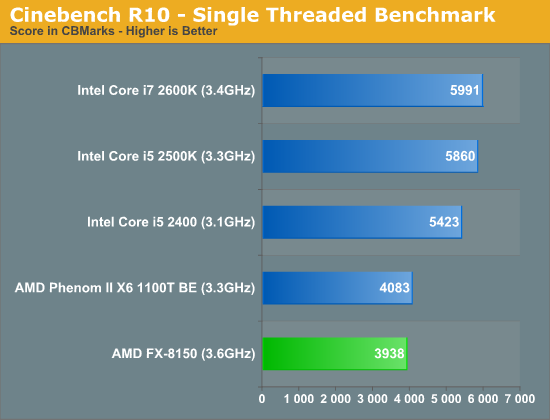
As I alluded to earlier, single threaded performance is going to be a bit of a disappointment with Bulldozer and here you get the first dose of reality. Even considering its clock speed and Turbo Core advantage, the FX-8150 is slower than the Phenom II X6 1100T. Intel's Core i5 2500K delivers nearly 50% better single threaded performance here than the FX-8150.
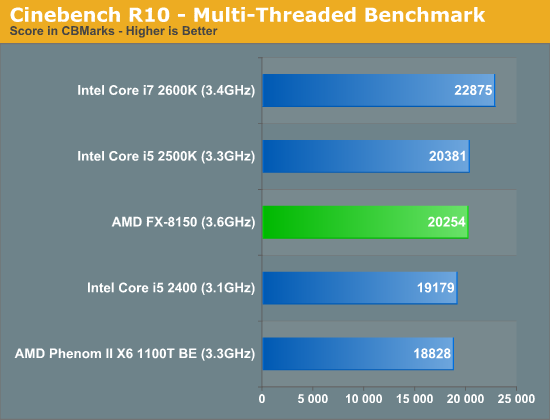
Crank up the threads and the FX-8150 shines, finally tying the 2500K at a comparable price point.
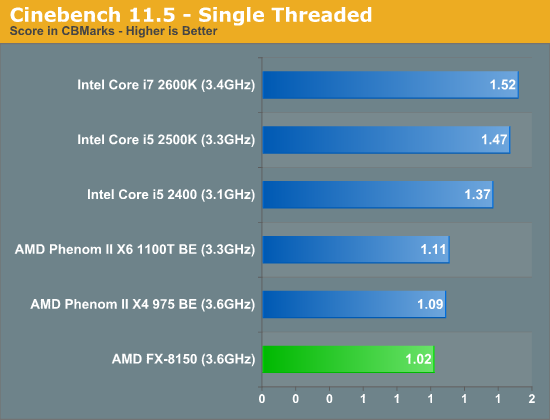
Even with more modern workloads, the FX-8150 isn't able to compete in single threaded speed. Here the 2500K is 44% faster.
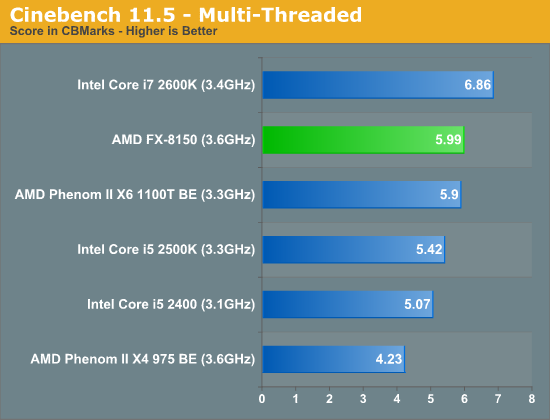
Modern multithreaded workloads however do quite well on Bulldozer. The gains over the old Phenom II X6 1100T are unfortunately not as large as we would expect them to be.
7-Zip Benchmark
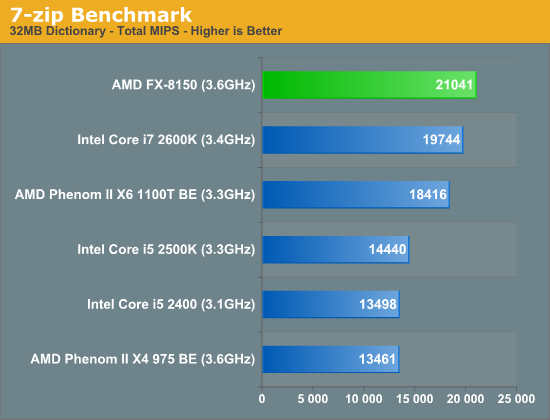
Heavily threaded workloads obviously do well on the FX series parts, here in our 7-zip test the FX-8150 is actually faster than Intel's fastest Sandy Bridge.
PAR2 Benchmark
Par2 is an application used for reconstructing downloaded archives. It can generate parity data from a given archive and later use it to recover the archive
Chuchusoft took the source code of par2cmdline 0.4 and parallelized it using Intel’s Threading Building Blocks 2.1. The result is a version of par2cmdline that can spawn multiple threads to repair par2 archives. For this test we took a 708MB archive, corrupted nearly 60MB of it, and used the multithreaded par2cmdline to recover it. The scores reported are the repair and recover time in seconds.
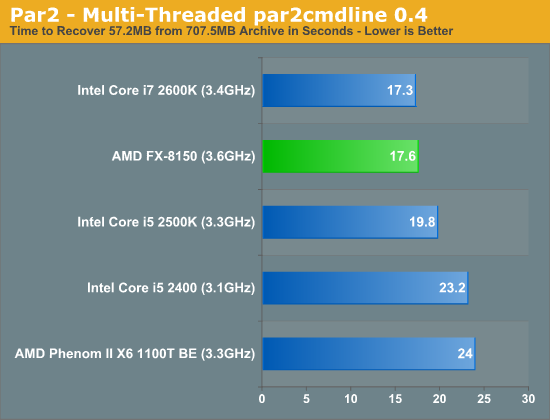
Once again, throw more threads at the processor and the FX-8150 can outperform the Core i5 2500K.
TrueCrypt Benchmark
TrueCrypt is a very popular encryption package that offers full AES-NI support. The application also features a built-in encryption benchmark that we can use to measure CPU performance with:
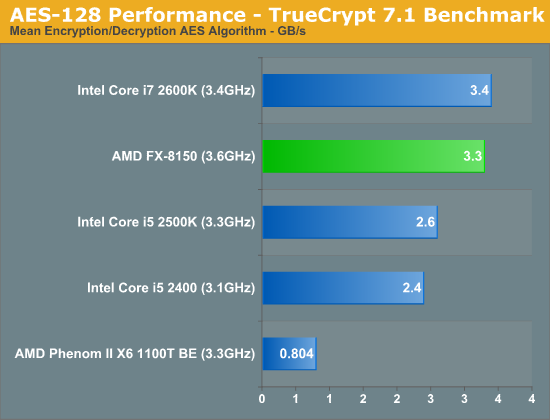
Bulldozer adds AES-NI acceleration, a feature that wasn't present in the Phenom II X6. As a result the FX-8150 is among the fastest at real time AES encryption/decryption, second only to the 2600K. Intel's artificial segmentation using Hyper Threading comes back to haunt it here as the 2500K is significantly slower than the 8-threaded beast.
x264 HD 3.03 Benchmark
Graysky's x264 HD test uses x264 to encode a 4Mbps 720p MPEG-2 source. The focus here is on quality rather than speed, thus the benchmark uses a 2-pass encode and reports the average frame rate in each pass.
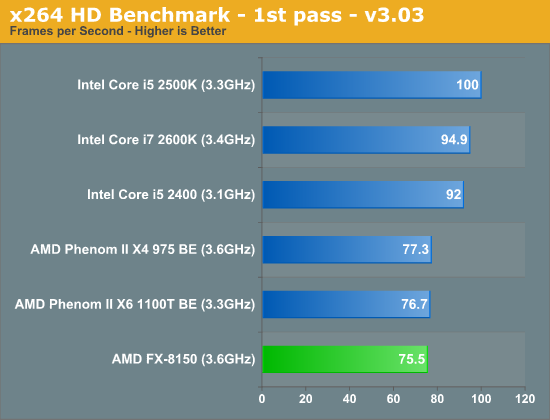
As I mentioned earlier, the first pass of our x264 HD benchmark is a lightly threaded task. As such, the FX-8150 doesn't do very well here. Even the old Phenom II is able to inch ahead of AMD's latest. And Sandy Bridge obviously does very well.

The second pass is more thread heavy, allowing the FX-8150 to flex its muscle and effectively tie the 2600K for first place.
AMD also sent along a couple of x264 binaries that were compiled with AVX and AMD XOP instruction flags. We ran both binaries through our x264 test, let's first look at what enabling AVX does to performance:
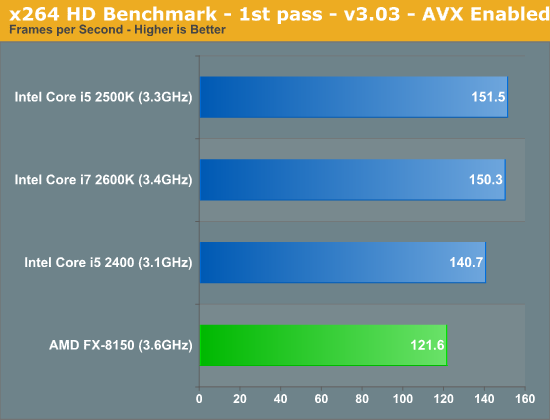
Everyone gets faster here, but Intel continues to hold onto a significant performance lead in lightly threaded workloads.
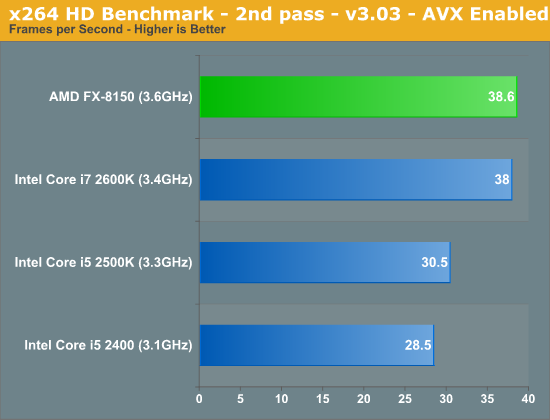
The standings don't change too much in the second pass, the frame rates are simply higher across the board. The FX-8150 is an x86 transcoding beast though, roughly equalling Intel's Core i7 2600K. Although not depicted here, the performance using the AMD XOP codepath was virtually identical to the AVX results.
Adobe Photoshop CS4
To measure performance under Photoshop CS4 we turn to the Retouch Artists’ Speed Test. The test does basic photo editing; there are a couple of color space conversions, many layer creations, color curve adjustment, image and canvas size adjustment, unsharp mask, and finally a gaussian blur performed on the entire image.
The whole process is timed and thanks to the use of Intel's X25-M SSD as our test bed hard drive, performance is far more predictable than back when we used to test on mechanical disks.
Time is reported in seconds and the lower numbers mean better performance. The test is multithreaded and can hit all four cores in a quad-core machine.
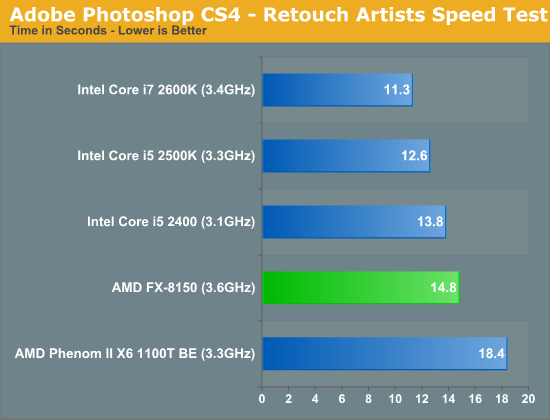
Photoshop performance improves tangibly over the Phenom II X6, unfortunately it's not enough to hang with the enthusiast Sandy Bridge parts.
Compile Chromium Test
You guys asked for it and finally I have something I feel is a good software build test. Using Visual Studio 2008 I'm compiling Chromium. It's a pretty huge project that takes over forty minutes to compile from the command line on a dual-core CPU. But the results are repeatable and the compile process will easily stress more than 8 threads on a CPU so it works for me.
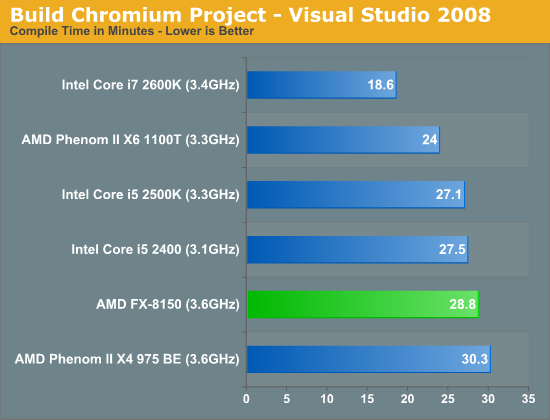
Our compiler test has traditionally favored heavily threaded architectures, but here we found the Phenom II X6 1100T to offer a tangible performance advantage over Bulldozer. While AMD is certainly competitive here, this is an example of one of those situations where AMD's architectural tradeoffs simply don't pay off—not without additional clock speed that is.
Excel Monte Carlo

Our final application test is another win for AMD over the Core i5 2500K. The victory is entirely a result of Intel's Hyper Threading restrictions though, the eight-thread 2600K is able to easily outperform Bulldozer. Either way, AMD delivers better performance here for less money.










430 Comments
View All Comments
psiboy - Monday, February 6, 2012 - link
What kind of retarded person would benchmark at 1024 x 768 on an enthusiast site where every one owns at least 1 1920 x 1080 monitor as they are 1. Dirt cheap and 2. The single biggest selling resolution for quite some time now... Real world across the board benches at 1920 x 1080 please!mumbles - Sunday, February 12, 2012 - link
I am not trying to discount the reviewer, the performance of Sandy Bridge, or games as a test of general application performance. I have no connection to company mentioned really anywhere on this site. I am just a software engineer with a degree in computer science who wants to let the world know why these metrics are not a good way to measure relative performance of different architectures.The world has changed drastically in the hardware world and the software world has no chance to keep up with it these days. Developing software implementations that utilize multiprocessors efficiently is extremely expensive and usually is not prioritized very well these days. Business requirements are the primary driver in even the gaming industry and "performs well enough on high end equipment(or in the business application world, on whatever equipment is available)" is almost always as good as a software engineer will be allowed time for on any task.
In performance minded sectors like gaming development and scientific computing, this results in implementations that are specific to hardware architectures that come from whatever company decides to sponsor the project. nVidia and Intel tend to be the ones that engage in these activities most of the time. Testing an application on a platform it was designed for will always yield better results than testing it on a new platform that nobody has had access to even develop software on. This results in a biased performance metric anytime a game is used as a benchmark.
In business applications, the concurrency is abstracted out of the engineer's view. We use messaging frameworks to process many small requests without having to manage concurrency at all. This is partly due to the business requirements changing so fast that optimizing anything results in it being replaced by something else instead. The underlying frameworks are typically optimized for abstraction instead of performance and are not intended to make use of any given hardware architecture. Obviously almost all of these systems use Java to achieve this, which is great because JIT takes care of optimizing things in real time for the hardware it is running on and the operations the software uses.
As games are developed for this architecture it will probably see far better benchmark results than the i series in those games which will actually be optimized for it.
A better approach to testing these architectures would be to develop tests that actually utilize the strengths of the new design rather than see how software optimized for some other architecture will perform. This is probably way more than an e-mag can afford to do, but I feel an injustice is being done here based on reading other people's comments that seem to put stock in this review as indication of actual performance of this architecture in the future, which really none of these tests indicate.
I bet this architecture actually does amazing things when running Java applications. Business application servers and gaming alike. Java makes heavy use of integer processing and concurrency, and this processor seems highly geared towards both.
And I just have to add, CINEBENCH is probably almost 100% floating point operations. This is probably why the Bulldozer does not perform any better than the Phenom II x4.
Also, AMD continues to impress on the value measurement. Check out the PassMarks per dollar on this bad boy:
http://www.cpubenchmark.net/cpu.php?cpu=AMD+FX-815...
djangry - Sunday, February 19, 2012 - link
Beware !!!! this chip is junk.I love Amd with all my heart and soul.
This fx chip is a black screen machine.
It breaks my heart to write this.
I am sending it back and trying to snag the last x6 phenom 2 's
I can find.
The fact that this chip is a dud is too well hidden.
When I called newegg they told me your the second one today with
horror stories about this chip.
msi would not come clean ...this chip is a turkey....
yet they were nice.
I will waste no more time with this nonsense.
my 754's work better.
We need honesty about the failure of this chip and the fact windows pulled the hot fix.
tlb bug part two.
Even linux users say after grub goes in Black screens.
Why isn't the industry coming clean on this issue.
Amd's 939 kicked Intel butt for 3 years- till they got it together,we need Amd ,but I do not like hidden issues and lack of disclosure.
Buyer beware!
AMDiamond - Monday, March 5, 2012 - link
Guys you are already upset because you spent your lunch money on Intel and even with higher this and that boards and memory AMD (even with half as much memory onboard [32GB] & Intel has [64GB] ) Intel is misquoting thier performance again...no matter what you say AMD= Dodge as to Intel=Cheverolet ..and when it gets down to AMD on the game versus Intel ...Intel has another hardcore asswhipping behind and ahead... its the same thing as a Dx4 processor(versus the pentium) even though Pentium had 1 comprehesion level higher ..when running the same programs DooM for example Pentium couldn't run DooM anywhere near as good as a simple DX4 amd..same stays true ...this Bulldozer has already broken unmatched records...AMD only lacks in 1 area..when you install windows the intel drivers already match at least 80 percent performance of Intel ...where AMD needs a specific narrow driver to run...once that driver is matched ..AMD =General Lee versus (Smokey & the) Bandits POS =Intel's comaro and its true ashamed that Intel even with 2x as much ddr3 memory ..cant even pickup the torch when AMD is smoking a Jet on the highway to hell for Intel -Hahahamauhahaha...sorry as intel qx9650 ahahahaahahahahahahahhahahahAMDiamond - Monday, March 5, 2012 - link
watch AMD take Diablo 3 (1 expansion by the next/it will be so ) Intel always lags hard on gaming compared to a weaker AMD class...point proven ...everest has alot of false benchmarks for Intel example NWN2 Phenom x3 8400 (triple core hasa bench 10880) yet a Intel Core 2 Duo e7500 has a bench of 12391 thats a 2.9ghtz cpu versus a 2.1ghtz CPU ..ok the kicker is intel is a dell amd is an aspire..DDR2 memory on the AMD and ddr3 memory on the intel ..all the intel bus features say higher (like they always do) but try running the same dammned video board on both systems then try running 132 NWN2 maps each medium size...no way the intel can do it ..the AMD can run the game editor and the maps at once..Intel is selling you a number AMD is selling you true frames per second..but your going to say oh but my Intel is a better core and this and that..ok now lets compare the price of the 2 systems...Intel was $2,500 the AMD was $400 ..why do you think that phenom just stomps the ass off that intel?(always has always will)zkeng - Wednesday, May 9, 2012 - link
I work as a building architect and use this CPU on my Linux workstation, in a Fractal Design define mini micro atx case, with 8GB ram and AMD radeon hd 6700 GPU.I usually have several applications running at the same time. Typically BricsCAD, a file manager, a web browser with a few tabs, Gimp image editor, music player, our business system and sometimes Virtualbox as well with a virtual machine.
I do allot of 3D projects and use Thea Render for photo rendering of building designs.
I use conky system monitor to watch the processor load and temperature.
These are my thoughts about the performance:
Runs cool and the noise level is low, because the processor can handle several applications without taking any stress at all.
Usually runs at only a few % average load for heavy business use (graphics and CAD in my case).
When working you get the feeling that this processor has good torque. Eight cores means most of the time every application can have at least one dedicated core and there is no lag even with lots of apps running. I think this will be a great advantage even if you use allot of older single core business applications.
The fact that this processor has rather high power consumption at full load is a factor to take into consideration if you put it under allot of constant load (and especially if you over clock).
For any use except really heavy duty CPU jobs (compiling software, photo rendering, video encoding) temporary load peaks will be taken care of in a few seconds, and you will typically see your processor working at only 1,4 GHz clock frequency. When idle the power consumption of this CPU is actually pretty low and temporary load peaks will make very little difference in total power consumption.
I sometimes photo render jobs for up to 32 hours and think of myself as a CPU demanding user, but still most of the time when my computer is running, it will be at idle frequency. I consider the idle power consumption to be by far the most important value of comparison between processors for 90% of all users. This is not considered in many benchmarks.
It is really nice to fire up Thea Render, use the power of all cores for interactive rendering mode while testing different materials on a design and then start an unbiased photo rendering and watch all eight cores flatten out with 100% load at 3,6 GHz.
Not only does this processor photo render slightly faster compared to my colleagues Intel Sandy Bridge. What is really nice is that i can run, lets say four renderings at the same time in the background, for a sun study, and then fire up BricsCAD to do drawing work while waiting. Trying to do this was a disaster with my last i5 processor. I forced me to do renderings during the night (out of business hours) or to borrow another work station during rendering jobs because my work station was locked up by more than one instance of the rendering application.
....................
To summarize, this is by far the best setup (CPU included) I have ever used on a work station. Affordable price, reasonably small case, low noise level, completely modular, i will be able to upgrade in the future without changing my am3+ mother board. The CPU is fast and offers superb multi tasking. This is the first processor I have ever used that also offers good multi tasking under heavy load (photo rendering + cad at the same time)
This is a superb CPU for any business user who likes to run several apps at the same time. It is also really fast with multi core optimized software.
AMD FX-8150 is my first AMD desktop processor and I like it just as much as I dislike their fusion APUs on the laptop market. Bulldozer has all the power where it is best needed, perfectly adopted to my work flow.
la'quv - Wednesday, August 29, 2012 - link
I don't know what it is with all this hype destroying amd's reputation. The bulldozer architecture is the best cpu design I have seen in years. I guess the underdog is not well respected. The bulldozer architecture has more pipelines and schedulers that the Core 2. The problem is code is compiled intel optimized not amd optimized. These benchmarks for a bunch of applications I don't use have no bearing on my choice to by a cpu, there are some benchmarks where an i5 will outperform and i7 so what valid comparison's are we making here. The bulldozer cpu's are dirt cheap and people expect them to be cheaper and don't require high clock speed ram and run on cheaper motherboards. AMD is expected to keep up with intel on the manufacturing process. Cutting corners and going down to 32nm then 22nm as quickly as possible does not produce stable chips. I have my kernel compiled AMD64 and it is not taxed by anything I am doing.brendandaly711 - Friday, September 6, 2013 - link
AMD still hasn't been able to pull out of the rut that INTEL left them in after the Sandy Bridge breakthrough. I am a (not so proud) owner of an FX-4100 in one of my pc's and an 8150 in the other. The 4100 compares to an ivy bridge i3 or a sandy bridge i5. I will give AMD partial credit, though, the 8150 performs at the ivy bridge's i5 level for almost identical prices.Nfarce - Sunday, September 20, 2020 - link
And here we are in 2020 some 9 years after this review and 7 years after your comment and AMD still hasn't been able to equal Intel as an equal gaming performance contender. AMD's only saving face is the fact that now higher resolution demands of 1440p and now 4K essentially make any modern game CPU bound and more dependent on the GPU power.BlueB - Wednesday, October 5, 2022 - link
I always come back to this review every few years just to have a good laugh looking back at this turd architecture, and especially at genius comments like:"You don't get the architecture"; "it's a server CPU"; "it's because Windows scheduler"; etc., etc.
No, it wasn't any of those things. The CPU's a turd. It was a turd then, it's a turd now, and it will be a turd no matter what. It wasn't more future-proof than either Sandy or Ivy, 2600Ks from 11 years ago still run circles around it in both single and multi-threaded apps, old and new. The class action lawsuit against AMD was the cherry on top.
It really never gets old to read through the golden comment section here and chuckle at all the visionary comments which tried to defend this absolute failure of an architecture. It's an excellent article, and together with its comment section will always have a special place in my heart.